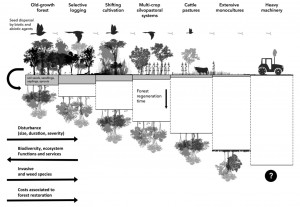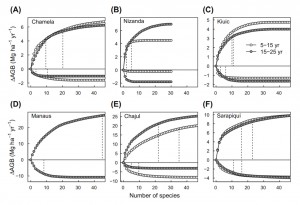
Archivos de la categoría: Noticias
Natural forest regeneration and ecological restoration in human modified tropical landscapes
Aparte
Natural forest regeneration and ecological restoration in human modified tropical landscapes
Miguel Martínez-Ramos, Aline Pingarroni, Jorge Rodríguez-Velázquez, Lilibeth Toledo Chelala, Isela Zermeño-Hernández, Frans Bongers
ABSTRACT
 In human-modified tropical landscapes (HMLs) the conservation of biodiversity, functions and services of forest ecosystems depends on persistence of old-growth forest remnants, forest regeneration in abandoned agricultural fields, and restoration of degraded lands. Understanding the impacts of agricultural land uses (ALUs) on forest regeneration is critical for biodiversity conservation in HMLs. Here, we develop a conceptual framework that considers the availability of propagules and the environment prevailing after field abandonment as two major determinants of forest regeneration in HMLs. The framework proposes that regeneration potential decreases with size, duration and severity of agricultural disturbance, reducing propagule availability and creating ill-suited environmental conditions for regeneration. We used studies from Southern Mexico to assess this framework. First, we identify regeneration bottlenecks that trees face during transit from seed to follow-up life stages, using demographic analysis of dominant pioneer species in recently abandoned fields. Then, we explore effects of ALUs on forest regeneration at the field and landscape scales, addressing major legacies. Finally, we integrate agricultural disturbance with landscape composition to predict attributes of successful second-growth forests in HMLs, and provide indicators useful to select tree native species for active restoration. An indicator of disturbance inflicted by ALUs, based on farmers’ information, predicted better regeneration potential than measurements of soil and microclimate conditions at time of abandonment. Cover of cattle pastures in the landscape was a stronger indicator of forest regenerating attributes than cover of old-growth forest remnants. To conclude, we offer recommendations to promote forest regeneration and biodiversity conservation in HMLs.
In human-modified tropical landscapes (HMLs) the conservation of biodiversity, functions and services of forest ecosystems depends on persistence of old-growth forest remnants, forest regeneration in abandoned agricultural fields, and restoration of degraded lands. Understanding the impacts of agricultural land uses (ALUs) on forest regeneration is critical for biodiversity conservation in HMLs. Here, we develop a conceptual framework that considers the availability of propagules and the environment prevailing after field abandonment as two major determinants of forest regeneration in HMLs. The framework proposes that regeneration potential decreases with size, duration and severity of agricultural disturbance, reducing propagule availability and creating ill-suited environmental conditions for regeneration. We used studies from Southern Mexico to assess this framework. First, we identify regeneration bottlenecks that trees face during transit from seed to follow-up life stages, using demographic analysis of dominant pioneer species in recently abandoned fields. Then, we explore effects of ALUs on forest regeneration at the field and landscape scales, addressing major legacies. Finally, we integrate agricultural disturbance with landscape composition to predict attributes of successful second-growth forests in HMLs, and provide indicators useful to select tree native species for active restoration. An indicator of disturbance inflicted by ALUs, based on farmers’ information, predicted better regeneration potential than measurements of soil and microclimate conditions at time of abandonment. Cover of cattle pastures in the landscape was a stronger indicator of forest regenerating attributes than cover of old-growth forest remnants. To conclude, we offer recommendations to promote forest regeneration and biodiversity conservation in HMLs.
Demographic Drivers of Aboveground Biomass Dynamics During Secondary Succession in Neotropical Dry and Wet Forests
Aparte
Demographic Drivers of Aboveground Biomass Dynamics During Secondary Succession in Neotropical Dry and Wet Forests
Danaë M. A. Rozendaal, Robin L. Chazdon, Felipe Arreola-Villa, Patricia Balvanera, Tony V. Bentos, Juan M. Dupuy, J. Luis Hernández-Stefanoni, Catarina C. Jakovac, Edwin E. Lebrija-Trejos, Madelon Lohbeck, Miguel Martínez-Ramos, Paulo E. S. Massoca, Jorge A. Meave, Rita C. G. Mesquita, Francisco Mora, Eduardo A. PérezGarcía, I. Eunice Romero-Pérez, Irving Saenz-Pedroza, Michiel van Breugel, G. Bruce Williamson, and Frans Bongers
ABSTRACT
 The magnitude of the carbon sink in second-growth forests is expected to vary with successional biomass dynamics resulting from tree growth, recruitment, and mortality, and with the effects of climate on these dynamics. We compare aboveground biomass dynamics of dry and wet Neotropical forests, based on monitoring data gathered over 3–16 years in forests covering the first 25 years of succession. We estimated standing biomass, annual biomass change, and contributions of tree growth, recruitment, and mortality. We also evaluated tree species’ contributions to biomass dynamics. Absolute rates of biomass change were lower in dry forests, 2.3 and 1.9 Mg ha-1 y-1 , after 5–15 and 15–25 years after abandonment, respectively, than in wet forests, with 4.7 and 6.1 Mg ha-1 y-1 , in the same age classes. Biomass change was largely driven by tree growth, accounting for at least 48% of biomass change across forest types and age classes. Mortality also contributed strongly to biomass change in wet forests of 5–15 years, whereas its contribution became important later in succession in dry forests. Biomass dynamics tended to be dominated by fewer species in early-successional dry than wet forests, but dominance was strong in both forest types. Overall, our results indicate that biomass dynamics during succession are faster in Neotropical wet than dry forests, with high tree mortality earlier in succession in the wet forests. Long-term monitoring of second-growth tropical forest plots is crucial for improving estimates of annual biomass change, and for enhancing understanding of the underlying mechanisms and demographic drivers.
The magnitude of the carbon sink in second-growth forests is expected to vary with successional biomass dynamics resulting from tree growth, recruitment, and mortality, and with the effects of climate on these dynamics. We compare aboveground biomass dynamics of dry and wet Neotropical forests, based on monitoring data gathered over 3–16 years in forests covering the first 25 years of succession. We estimated standing biomass, annual biomass change, and contributions of tree growth, recruitment, and mortality. We also evaluated tree species’ contributions to biomass dynamics. Absolute rates of biomass change were lower in dry forests, 2.3 and 1.9 Mg ha-1 y-1 , after 5–15 and 15–25 years after abandonment, respectively, than in wet forests, with 4.7 and 6.1 Mg ha-1 y-1 , in the same age classes. Biomass change was largely driven by tree growth, accounting for at least 48% of biomass change across forest types and age classes. Mortality also contributed strongly to biomass change in wet forests of 5–15 years, whereas its contribution became important later in succession in dry forests. Biomass dynamics tended to be dominated by fewer species in early-successional dry than wet forests, but dominance was strong in both forest types. Overall, our results indicate that biomass dynamics during succession are faster in Neotropical wet than dry forests, with high tree mortality earlier in succession in the wet forests. Long-term monitoring of second-growth tropical forest plots is crucial for improving estimates of annual biomass change, and for enhancing understanding of the underlying mechanisms and demographic drivers.
The importance of biodiversity and dominance for multiple ecosystem functions in a human-modified tropical landscape
Aparte
The importance of biodiversity and dominance for multiple ecosystem functions in a human-modified tropical landscape
Madelon Lohbeck, Frans Bongers, Miguel Martinez-Ramos, Lourens Poorter
Abstract
Many studies suggest that biodiversity may be particularly important for ecosystem multifunctionality, because different species with different traits can contribute to different functions. Support, however, comes mostly from experimental studies conducted at small spatial scales in low-diversity systems. Here, we test whether different species contribute to different ecosystem functions that are important for carbon cycling in a high-diversity human-modified tropical forest landscape in Southern Mexico. We quantified aboveground standing biomass, primary productivity, litter production, and wood decomposition at the landscape level, and evaluated the extent to which tree species contribute to these ecosystem functions. We used simulations to tease apart the effects of species richness, species dominance and species functional traits on ecosystem functions. We found that dominance was more important than species traits in determining a species’ contribution to ecosystem functions. As a consequence of the high dominance in human-modified landscapes, the same small subset of species mattered across different functions. In human-modified landscapes in the tropics, biodiversity may play a limited role for ecosystem multifunctionality due to the potentially large effect of species dominance on biogeochemical functions. However, given the spatial and temporal turnover in species dominance, biodiversity may be critically important for the maintenance and resilience of ecosystem functions.



